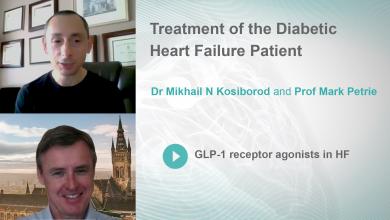Search results
Author(s):
Carine E Hamo
,
Michelle W Bloom
Added:
3 years ago
Heart disease and cancer are the two leading causes of death, together accounting for almost 50 % of deaths in the US.1 Unfortunately, the tremendous success in improving cancer survival is often attenuated by downstream cardiovascular complications from cancer therapy. Acute cardiac toxicity may limit the ability to use life-saving cancer therapy and chronic toxicity limits overall survival. As…
View more
Author(s):
Mark Sweeney
,
Angela Yiu
,
Alexander Lyon
Added:
3 years ago
Cancer and the anti-cancer treatments prescribed by oncologists have long been known to have significant effects on muscle, causing a catabolic muscle wasting state and resulting in widespread and progressive atrophy of most muscle groups.1 This process contributes significantly to the cancer cachexia seen in up to 80% of all patients with cancer, resulting in progressive weight loss, loss of…
View more
Author(s):
Giuseppe Rosano
,
Cristiana Vitale
,
Petar M Seferovic
Added:
3 years ago
Diabetes mellitus is highly prevalent amongst patients with heart failure, especially those with heart failure and preserved ejection fraction (HFpEF), and patients with the two conditions have a higher risk of mortality compared with patients without diabetes or heart failure.1–3 Diabetic patients have an increased risk of developing heart failure because of the abnormal cardiac handling of…
View more
Author(s):
Cristiana Vitale
,
Ilaria Spoletini
,
Giuseppe Rosano
Added:
3 years ago
Because of the ageing population in industrialised countries, the prevalence of cardiovascular disease has dramatically increased.1 In particular, heart failure (HF) has become a major public health problem and the leading cause of morbidity, hospitalisation and mortality in older people.2,3
Patients with HF, especially the oldest, are often characterised by a “vulnerability status” due to the…
View more
Author(s):
Josep Comin-Colet
Added:
9 years ago
e-SPACE HF 2023 – Day Two
Author(s):
William T Abraham
,
Stefan Anker
,
Deepak L Bhatt
,
et al
Start date:
Oct 21, 2023
Broadcast
Author(s):
Tomaz Podlesnikar
,
Victoria Delgado
,
Jeroen J Bax
Added:
3 years ago
Heart failure (HF) is a rapidly growing public health problem with an estimated prevalence of more than 26 million people worldwide.1 In developed countries the prevalence is 1–2% peaking at ≥10% among people aged over 70 years.2 In the US, the lifetime risk of developing HF is 20% among people aged 40 years or older.3 Diagnosing the underlying cause of HF is central to the choice of appropriate…
View more
Author(s):
Mitja Lainscak
Added:
7 years ago
Interview with Professor Mitja Lainscak from General Hospital Murska Sobota, Murska Sobota, Slovenia at HFA 2017.
View more
Treatment of the Diabetic Heart Failure Patient
Author(s):
Mikhail Kosiborod
,
Mark Petrie
Added:
3 years ago
Video Series
Author(s):
Sunil K Nadar
,
Muhammad Mujtaba Shaikh
Added:
3 years ago
The National Institutes of Health Biomarkers Definitions Working Group define a biomarker as “a characteristic that is objectively measured and evaluated as an indicator of normal biological processes, pathogenic processes, or pharmacologic responses to a therapeutic intervention”.1 Biomarkers have become increasingly important in current medical practice as they offer an easy way to either…
View more














 « First
« First